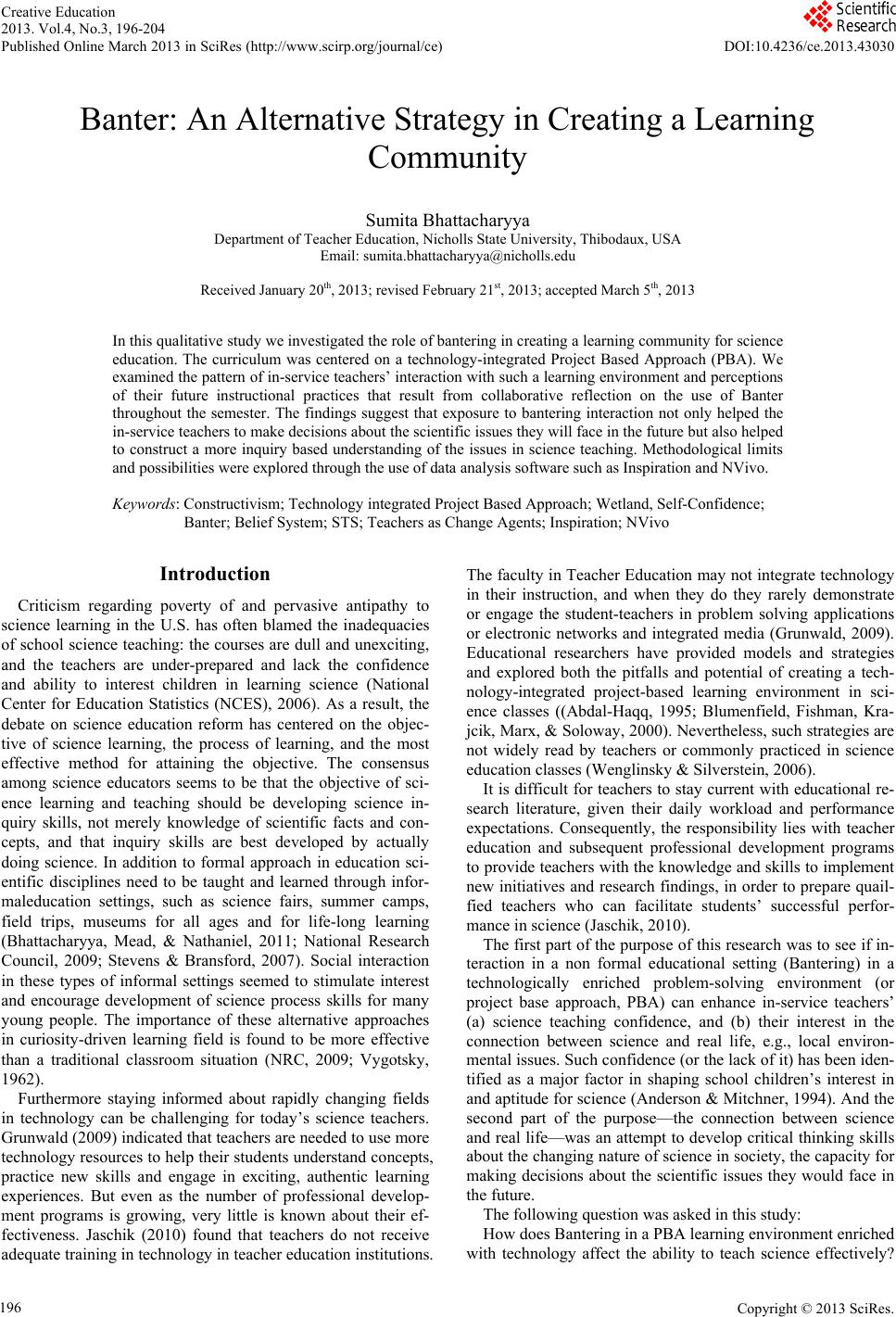 Creative Education 2013. Vol.4, No.3, 196-204 Published Online March 2013 in SciRes (http://www.scirp.org/journal/ce) DOI:10.4236/ce.2013.43030 Banter: An Alternative Strategy in Creating a Learning Community Sumita Bhattacharyya Department of Te ac her Education, Nicholls State University, Thibodaux, USA Email: sumita.bhat ta ch aryya@nicholls.edu Received January 20th, 2013; revised February 21st, 2013; accepted March 5th, 2013 In this qualitative study we investigated the role of bantering in creating a learning community for science education. The curriculum was centered on a technology-integrated Project Based Approach (PBA). We examined the pattern of in-service teachers’ interaction with such a learning environment and perceptions of their future instructional practices that result from collaborative reflection on the use of Banter throughout the semester. The findings suggest that exposure to bantering interaction not only helped the in-service teachers to make decisions about the scientific issues they will face in the future but also helped to construct a more inquiry based understanding of the issues in science teaching. Methodological limits and possibilities were explored through the use of data analysis software such as Inspiration and NVivo. Keywords: Constructivism; Technology integrated Project Based Approach; Wetland, Self-Confidence; Banter; Belief System; STS; Teachers as Change Agents; Inspiration; NVivo Introduction Criticism regarding poverty of and pervasive antipathy to science learning in the U.S. has often blamed the inadequacies of school science teaching: the courses are dull and unexciting, and the teachers are under-prepared and lack the confidence and ability to interest children in learning science (National Center for Education Statistics (NCES), 2006). As a result, the debate on science education reform has centered on the objec- tive of science learning, the process of learning, and the most effective method for attaining the objective. The consensus among science educators seems to be that the objective of sci- ence learning and teaching should be developing science in- quiry skills, not merely knowledge of scientific facts and con- cepts, and that inquiry skills are best developed by actually doing science. In addition to formal approach in education sci- entific disciplines need to be taught and learned through infor- maleducation settings, such as science fairs, summer camps, field trips, museums for all ages and for life-long learning (Bhattacharyya, Mead, & Nathaniel, 2011; National Research Council, 2009; Stevens & Bransford, 2007). Social interaction in these types of informal settings seemed to stimulate interest and encourage development of science process skills for many young people. The importance of these alternative approaches in curiosity-driven learning field is found to be more effective than a traditional classroom situation (NRC, 2009; Vygotsky, 1962). Furthermore staying informed about rapidly changing fields in technology can be challenging for today’s science teachers. Grunwald (2009) indicated that teachers are needed to use more technology resources to help their students understand concepts, practice new skills and engage in exciting, authentic learning experiences. But even as the number of professional develop- ment programs is growing, very little is known about their ef- fectiveness. Jaschik (2010) found that teachers do not receive adequate training in technology in teacher education institutions. The faculty in Teacher Education may not integrate technology in their instruction, and when they do they rarely demonstrate or engage the student-teachers in problem solving applications or electronic networks and integrated media (Grunwald, 2009). Educational researchers have provided models and strategies and explored both the pitfalls and potential of creating a tech- nology-integrated project-based learning environment in sci- ence classes ((Abdal-Haqq, 1995; Blumenfield, Fishman, Kra- jcik, Marx, & Soloway, 2000). Nevertheless, such strategies are not widely read by teachers or commonly practiced in science education classes (Wenglinsky & Silverstein, 2006). It is difficult for teachers to stay current with educational re- search literature, given their daily workload and performance expectations. Consequently, the responsibility lies with teacher education and subsequent professional development programs to provide teachers with the knowledge and skills to implement new initiatives and research findings, in order to prepare quail- fied teachers who can facilitate students’ successful perfor- mance in science (Jaschik, 2010). The first part of the purpose of this research was to see if in- teraction in a non formal educational setting (Bantering) in a technologically enriched problem-solving environment (or project base approach, PBA) can enhance in-service teachers’ (a) science teaching confidence, and (b) their interest in the connection between science and real life, e.g., local environ- mental issues. Such confidence (or the lack of it) has been iden- tified as a major factor in shaping school children’s interest in and aptitude for science (Anderson & Mitchner, 1994). And the second part of the purpose—the connection between science and real life—was an attempt to develop critical thinking skills about the changing nature of science in society, the capacity for making decisions about the scientific issues they would face in the future. The following question was asked in this study: How does Bantering in a PBA learning environment enriched with technology affect the ability to teach science effectively? Copyright © 2013 SciRe s . 196 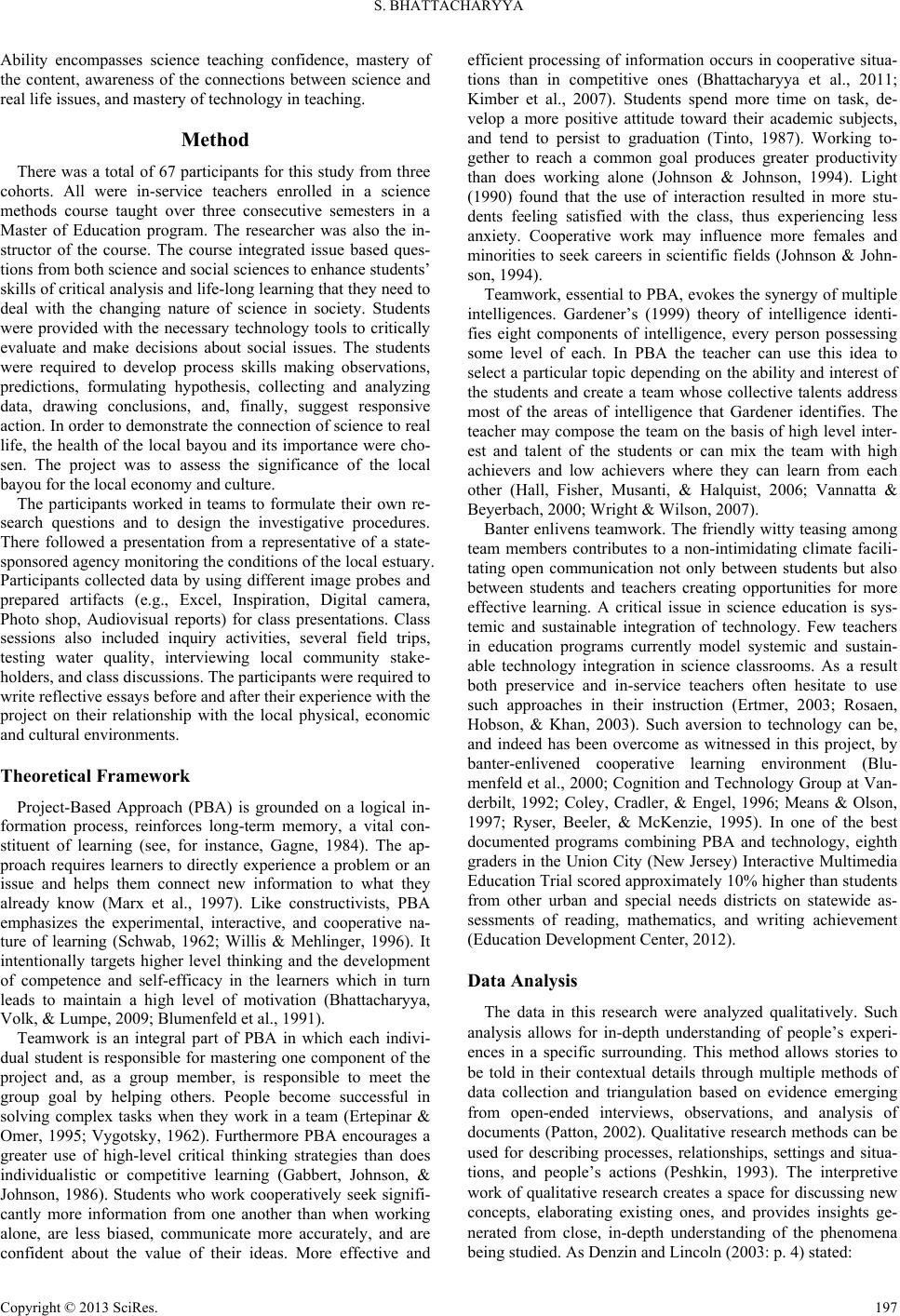 S. BHATTACHARYYA Ability encompasses science teaching confidence, mastery of the content, awareness of the connections between science and real life issues, and mastery of technology in teaching. Method There was a total of 67 participants for this study from three cohorts. All were in-service teachers enrolled in a science methods course taught over three consecutive semesters in a Master of Education program. The researcher was also the in- structor of the course. The course integrated issue based ques- tions from both science and social sciences to enhance students’ skills of critical analysis and life-long learning that they need to deal with the changing nature of science in society. Students were provided with the necessary technology tools to critically evaluate and make decisions about social issues. The students were required to develop process skills making observations, predictions, formulating hypothesis, collecting and analyzing data, drawing conclusions, and, finally, suggest responsive action. In order to demonstrate the connection of science to real life, the health of the local bayou and its importance were cho- sen. The project was to assess the significance of the local bayou for the local economy and culture. The participants worked in teams to formulate their own re- search questions and to design the investigative procedures. There followed a presentation from a representative of a state- sponsored agency monitoring the conditions of the local estuary. Participants collected data by using different image probes and prepared artifacts (e.g., Excel, Inspiration, Digital camera, Photo shop, Audiovisual reports) for class presentations. Class sessions also included inquiry activities, several field trips, testing water quality, interviewing local community stake- holders, and class discussions. The participants were required to write reflective essays before and after their experience with the project on their relationship with the local physical, economic and cultural environments. Theoretical Framework Project-Based Approach (PBA) is grounded on a logical in- formation process, reinforces long-term memory, a vital con- stituent of learning (see, for instance, Gagne, 1984). The ap- proach requires learners to directly experience a problem or an issue and helps them connect new information to what they already know (Marx et al., 1997). Like constructivists, PBA emphasizes the experimental, interactive, and cooperative na- ture of learning (Schwab, 1962; Willis & Mehlinger, 1996). It intentionally targets higher level thinking and the development of competence and self-efficacy in the learners which in turn leads to maintain a high level of motivation (Bhattacharyya, Volk, & Lumpe, 2009; Blumenfeld et al., 1991). Teamwork is an integral part of PBA in which each indivi- dual student is responsible for mastering one component of the project and, as a group member, is responsible to meet the group goal by helping others. People become successful in solving complex tasks when they work in a team (Ertepinar & Omer, 1995; Vygotsky, 1962). Furthermore PBA encourages a greater use of high-level critical thinking strategies than does individualistic or competitive learning (Gabbert, Johnson, & Johnson, 1986). Students who work cooperatively seek signifi- cantly more information from one another than when working alone, are less biased, communicate more accurately, and are confident about the value of their ideas. More effective and efficient processing of information occurs in cooperative situa- tions than in competitive ones (Bhattacharyya et al., 2011; Kimber et al., 2007). Students spend more time on task, de- velop a more positive attitude toward their academic subjects, and tend to persist to graduation (Tinto, 1987). Working to- gether to reach a common goal produces greater productivity than does working alone (Johnson & Johnson, 1994). Light (1990) found that the use of interaction resulted in more stu- dents feeling satisfied with the class, thus experiencing less anxiety. Cooperative work may influence more females and minorities to seek careers in scientific fields (Johnson & John- son, 1994). Teamwork, essential to PBA, evokes the synergy of multiple intelligences. Gardener’s (1999) theory of intelligence identi- fies eight components of intelligence, every person possessing some level of each. In PBA the teacher can use this idea to select a particular t opic depending on the ability and interest of the students and create a team whose collective talents address most of the areas of intelligence that Gardener identifies. The teacher may compose the team on the basis of high level inter- est and talent of the students or can mix the team with high achievers and low achievers where they can learn from each other (Hall, Fisher, Musanti, & Halquist, 2006; Vannatta & Beyerbach, 2000; Wright & Wilson, 2007). Banter enlivens teamwork. The friendly witty teasing among team members contributes to a non-intimidating climate facili- tating open communication not only between students but also between students and teachers creating opportunities for more effective learning. A critical issue in science education is sys- temic and sustainable integration of technology. Few teachers in education programs currently model systemic and sustain- able technology integration in science classrooms. As a result both preservice and in-service teachers often hesitate to use such approaches in their instruction (Ertmer, 2003; Rosaen, Hobson, & Khan, 2003). Such aversion to technology can be, and indeed has been overcome as witnessed in this project, by banter-enlivened cooperative learning environment (Blu- menfeld et al., 2000; Cognition and Technology Group at Van- derbilt, 1992; Coley, Cradler, & Engel, 1996; Means & Olson, 1997; Ryser, Beeler, & McKenzie, 1995). In one of the best documented programs combining PBA and technology, eighth graders in the Union City (New Jersey) Interactive Multimedia Education Trial scored approximately 10% higher than students from other urban and special needs districts on statewide as- sessments of reading, mathematics, and writing achievement (Education Development Center, 2012). Data Analysis The data in this research were analyzed qualitatively. Such analysis allows for in-depth understanding of people’s experi- ences in a specific surrounding. This method allows stories to be told in their contextual details through multiple methods of data collection and triangulation based on evidence emerging from open-ended interviews, observations, and analysis of documents (Patton, 2002). Qualitative research methods can be used for describing processes, relationships, settings and situa- tions, and people’s actions (Peshkin, 1993). The interpretive work of qualitative research creates a space for discussing new concepts, elaborating existing ones, and provides insights ge- nerated from close, in-depth understanding of the phenomena being studied. As Denzin and Lincoln (2003: p. 4) stated: Copyright © 2013 SciRe s . 197 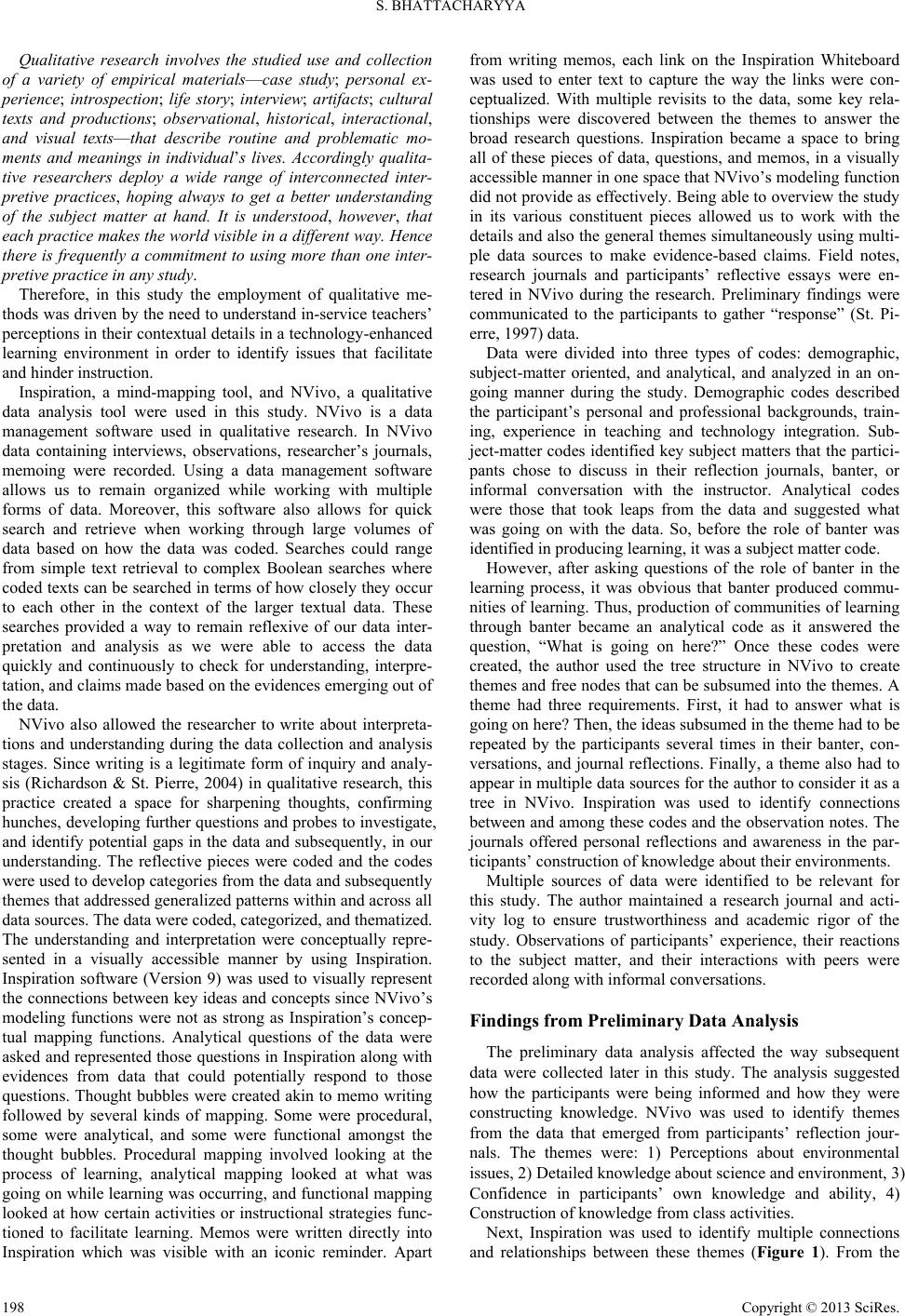 S. BHATTACHARYYA Qualitative research involves the studied use and collection of a variety of empirical materials—case study; personal ex- perience; introspection; life story; interview; artifacts; cultural texts and productions; observational, historical, interactional, and visual texts—that describe routine and problematic mo- ments and meanings in individual’s lives. Accordingly qualita- tive researchers deploy a wide range of interconnected inter- pretive practices, hoping always to get a better understanding of the subject matter at hand. It is understood, however, that each practice makes the world visible in a different way. Hence there is frequently a commitment to using more than one inter- pretive practice in any study. Therefore, in this study the employment of qualitative me- thods was driven by the need to understand in-service teachers’ perceptions in their contextual details in a technology-enhanced learning environment in order to identify issues that facilitate and hinder instruction. Inspiration, a mind-mapping tool, and NVivo, a qualitative data analysis tool were used in this study. NVivo is a data management software used in qualitative research. In NVivo data containing interviews, observations, researcher’s journals, memoing were recorded. Using a data management software allows us to remain organized while working with multiple forms of data. Moreover, this software also allows for quick search and retrieve when working through large volumes of data based on how the data was coded. Searches could range from simple text retrieval to complex Boolean searches where coded texts can be searched in terms of how closely they occur to each other in the context of the larger textual data. These searches provided a way to remain reflexive of our data inter- pretation and analysis as we were able to access the data quickly and continuously to check for understanding, interpre- tation, and claims made based on the evidences emerging out of the data. NVivo also allowed the researcher to write about interpreta- tions and understanding during the data collection and analysis stages. Since writing is a legitimate form of inquiry and analy- sis (Richardson & St. Pierre, 2004) in qualitative research, this practice created a space for sharpening thoughts, confirming hunches, developing further questions and probes to investigate, and identify potential gaps in the data and subsequently, in our understanding. The reflective pieces were coded and the codes were us ed t o de velo p ca tego rie s from the data and subsequently themes that addressed generalized patterns within and across all data sources. The data were coded, categorized, and thematized. The understanding and interpretation were conceptually repre- sented in a visually accessible manner by using Inspiration. Inspiration software (Version 9) was used to visually represent the connections between key ideas and concepts since NVivo’s modeling functions were not as strong as Inspiration’s concep- tual mapping functions. Analytical questions of the data were asked and represented those questions in Inspiration along with evidences from data that could potentially respond to those questions. Thought bubbles were created akin to memo writing followed by several kinds of mapping. Some were procedural, some were analytical, and some were functional amongst the thought bubbles. Procedural mapping involved looking at the process of learning, analytical mapping looked at what was going on while learning was occurring, and functional mapping looked at how certain activities or instructional strategies func- tioned to facilitate learning. Memos were written directly into Inspiration which was visible with an iconic reminder. Apart from writing memos, each link on the Inspiration Whiteboard was used to enter text to capture the way the links were con- ceptualized. With multiple revisits to the data, some key rela- tionships were discovered between the themes to answer the broad research questions. Inspiration became a space to bring all of these pieces of data, questions, and memos, in a visually accessible manner in one space that NVivo’s modeling function did not provide as effectively. Being able to overview the study in its various constituent pieces allowed us to work with the details and also the general themes simultaneously using multi- ple data sources to make evidence-based claims. Field notes, research journals and participants’ reflective essays were en- tered in NVivo during the research. Preliminary findings were communicated to the participants to gather “response” (St. Pi- erre, 1997) data. Data were divided into three types of codes: demographic, subject-matter oriented, and analytical, and analyzed in an on- going manner during the study. Demographic codes described the participant’s personal and professional backgrounds, train- ing, experience in teaching and technology integration. Sub- ject-matter codes identified key subject matters that the partici- pants chose to discuss in their reflection journals, banter, or informal conversation with the instructor. Analytical codes were those that took leaps from the data and suggested what was going on with the data. So, before the role of banter was identified in producing learning, it was a subject matter code. However, after asking questions of the role of banter in the learning process, it was obvious that banter produced commu- nities of learning. Thus, production of communities of learning through banter became an analytical code as it answered the question, “What is going on here?” Once these codes were created, the author used the tree structure in NVivo to create themes and free nodes that can be subsumed into the themes. A theme had three requirements. First, it had to answer what is going on here? Then, the ideas subsumed in the theme had to be repeated by the participants several times in their banter, con- versations, and journal reflections. Finally, a theme also had to appear in multiple data sources for the author to consider it as a tree in NVivo. Inspiration was used to identify connections between and among these codes and the observation notes. The journals offered personal reflections and awareness in the par- ticipants’ construction of knowledge about their environments. Multiple sources of data were identified to be relevant for this study. The author maintained a research journal and acti- vity log to ensure trustworthiness and academic rigor of the study. Observations of participants’ experience, their reactions to the subject matter, and their interactions with peers were recorded along with informal conversations. Findings from Preliminary Data Analysis The preliminary data analysis affected the way subsequent data were collected later in this study. The analysis suggested how the participants were being informed and how they were constructing knowledge. NVivo was used to identify themes from the data that emerged from participants’ reflection jour- nals. The themes were: 1) Perceptions about environmental issues, 2) Detailed knowledge about science and environment, 3) Confidence in participants’ own knowledge and ability, 4) Construction of knowledge from class activities. Next, Inspiration was used to identify multiple connections and relationships between these themes (Figure 1). From the Copyright © 2013 SciRe s . 198 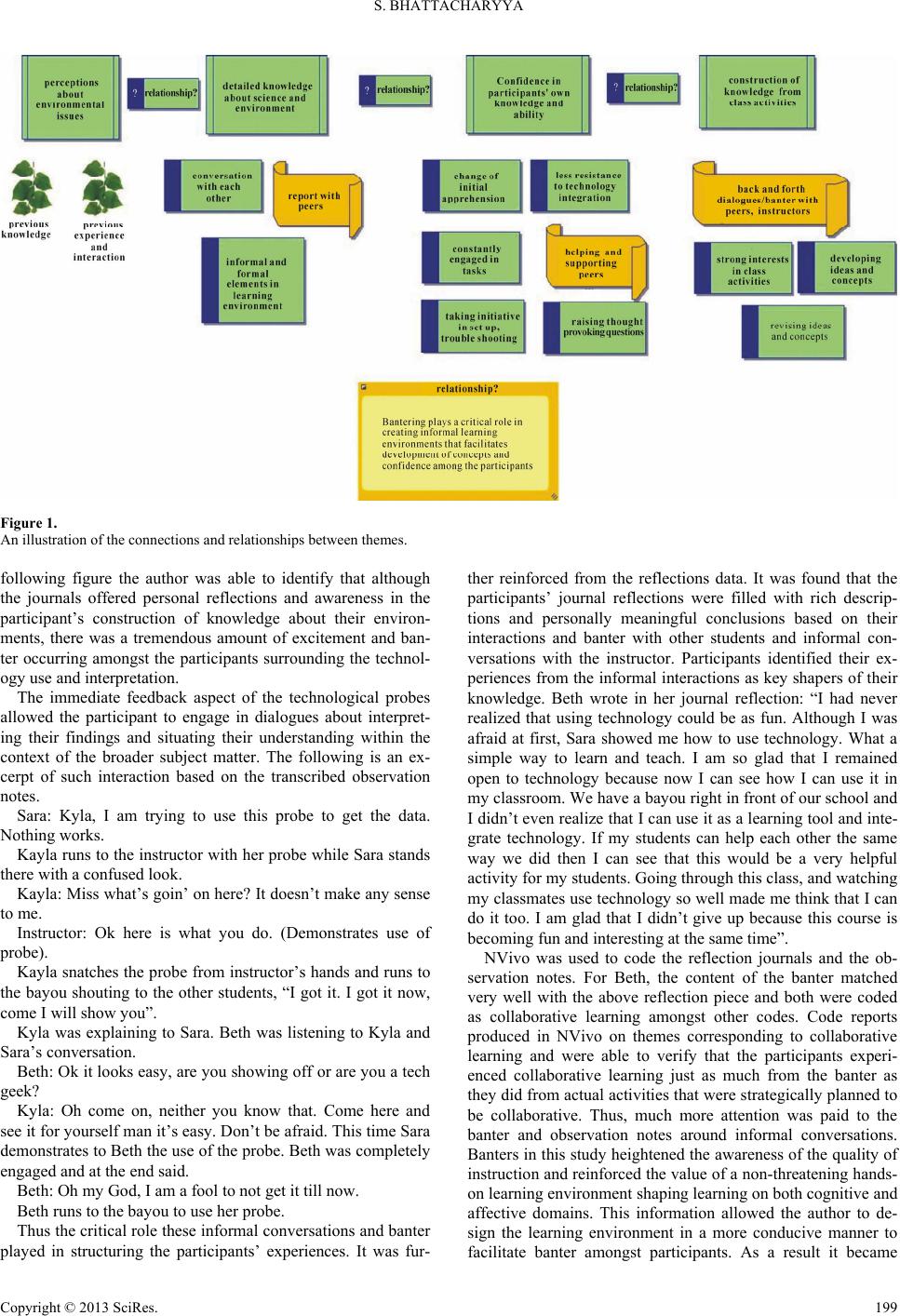 S. BHATTACHARYYA Copyright © 2013 SciRe s . 199 Figure 1. An illustration of the connections and relationships between themes. following figure the author was able to identify that although the journals offered personal reflections and awareness in the participant’s construction of knowledge about their environ- ments, there was a tremendous amount of excitement and ban- ter occurring amongst the participants surrounding the technol- ogy use and interpretation. The immediate feedback aspect of the technological probes allowed the participant to engage in dialogues about interpret- ing their findings and situating their understanding within the context of the broader subject matter. The following is an ex- cerpt of such interaction based on the transcribed observation notes. Sara: Kyla, I am trying to use this probe to get the data. Nothing works. Kayla runs to the instructor with her probe while Sara stands there with a confused look. Kayla: Miss what’s goin’ on here? It doesn’t make any sense to me. Instructor: Ok here is what you do. (Demonstrates use of probe). Kayla snatches the probe from instructor’s hands and runs to the bayou shouting to the other students, “I got it. I got it now, come I wil l show you”. Kyla was explaining to Sara. Beth was listening to Kyla and Sara’s conversation. Beth: Ok it looks easy, are you showing off or are you a tech geek? Kyla: Oh come on, neither you know that. Come here and see it for yourself man it’s easy. Don’t be afraid. This time Sara demonstrates to Beth the use of the probe. Beth was completely engaged and at the end said. Beth: Oh my God, I am a fool to not get it till now. Beth runs to the bayou to use her probe. Thus the critical role these informal conversations and banter played in structuring the participants’ experiences. It was fur- ther reinforced from the reflections data. It was found that the participants’ journal reflections were filled with rich descrip- tions and personally meaningful conclusions based on their interactions and banter with other students and informal con- versations with the instructor. Participants identified their ex- periences from the informal interactions as key shapers of their knowledge. Beth wrote in her journal reflection: “I had never realized that using technology could be as fun. Although I was afraid at first, Sara showed me how to use technology. What a simple way to learn and teach. I am so glad that I remained open to technology because now I can see how I can use it in my classroom. We have a bayou right in front of our school and I didn’t even realize that I can use it as a learning tool and inte- grate technology. If my students can help each other the same way we did then I can see that this would be a very helpful activity for my students. Going through this class, and watching my classmates use technology so well made me think that I can do it too. I am glad that I didn’t give up because this course is becoming fun and interesting at the same time”. NVivo was used to code the reflection journals and the ob- servation notes. For Beth, the content of the banter matched very well with the above reflection piece and both were coded as collaborative learning amongst other codes. Code reports produced in NVivo on themes corresponding to collaborative learning and were able to verify that the participants experi- enced collaborative learning just as much from the banter as they did from actual activities that were strategically planned to be collaborative. Thus, much more attention was paid to the banter and observation notes around informal conversations. Banters in this study heightened the awareness of the quality of instruction and reinforced the value of a non-threatening hands- on learning environment shaping learning on both cognitive and affective domains. This information allowed the author to de- sign the learning environment in a more conducive manner to facilitate banter amongst participants. As a result it became 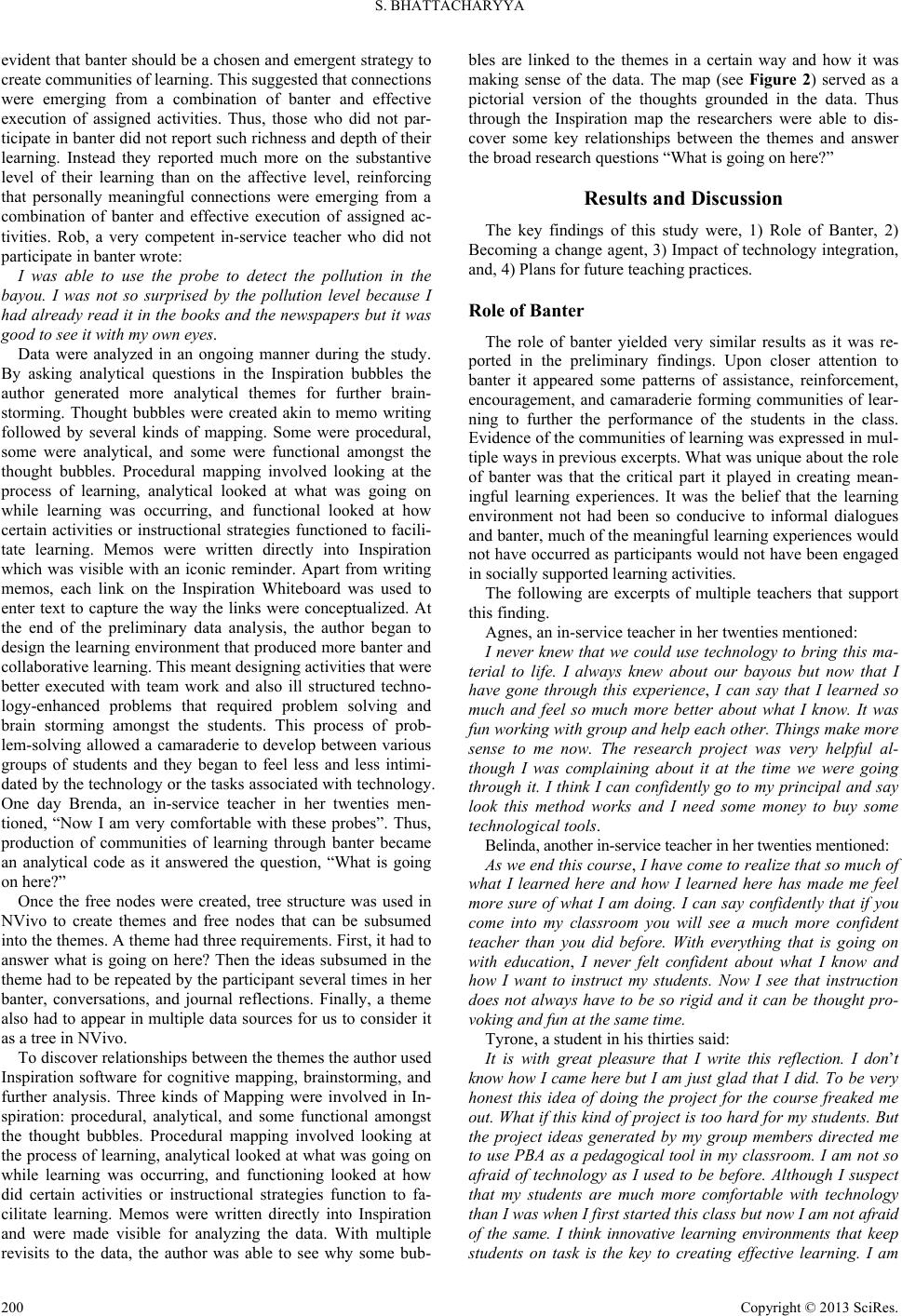 S. BHATTACHARYYA evident that banter should be a chosen and emergent strategy to create communities of learning. This suggested that connections were emerging from a combination of banter and effective execution of assigned activities. Thus, those who did not par- ticipate in banter did not report such richness and depth of their learning. Instead they reported much more on the substantive level of their learning than on the affective level, reinforcing that personally meaningful connections were emerging from a combination of banter and effective execution of assigned ac- tivities. Rob, a very competent in-service teacher who did not participate in banter wrote: I was able to use the probe to detect the pollution in the bayou. I was not so surprised by the pollution level because I had already read it in the books and the newspapers but it was good to see it with my own eyes. Data were analyzed in an ongoing manner during the study. By asking analytical questions in the Inspiration bubbles the author generated more analytical themes for further brain- storming. Thought bubbles were created akin to memo writing followed by several kinds of mapping. Some were procedural, some were analytical, and some were functional amongst the thought bubbles. Procedural mapping involved looking at the process of learning, analytical looked at what was going on while learning was occurring, and functional looked at how certain activities or instructional strategies functioned to facili- tate learning. Memos were written directly into Inspiration which was visible with an iconic reminder. Apart from writing memos, each link on the Inspiration Whiteboard was used to enter text to capture the way the links were conceptualized. At the end of the preliminary data analysis, the author began to design the learning environment that produced more banter and collaborative learning. This meant designing activities that were better executed with team work and also ill structured techno- logy-enhanced problems that required problem solving and brain storming amongst the students. This process of prob- lem-solving allowed a camaraderie to develop between various groups of students and they began to feel less and less intimi- dated by the technology or the tasks associated with technology. One day Brenda, an in-service teacher in her twenties men- tioned, “Now I am very comfortable with these probes”. Thus, production of communities of learning through banter became an analytical code as it answered the question, “What is going on here?” Once the free nodes were created, tree structure was used in NVivo to create themes and free nodes that can be subsumed into the themes. A theme had three requirements. First, it had to answer what is going on here? Then the ideas subsumed in the theme had to be repeated by the participant several times in her banter, conversations, and journal reflections. Finally, a theme also had to appear in multiple data sources for us to consider it as a tree in NVivo. To discover relationships between the themes the author used Inspiration software for cognitive mapping, brainstorming, and further analysis. Three kinds of Mapping were involved in In- spiration: procedural, analytical, and some functional amongst the thought bubbles. Procedural mapping involved looking at the process of learning, analytical looked at what was going on while learning was occurring, and functioning looked at how did certain activities or instructional strategies function to fa- cilitate learning. Memos were written directly into Inspiration and were made visible for analyzing the data. With multiple revisits to the data, the author was able to see why some bub- bles are linked to the themes in a certain way and how it was making sense of the data. The map (see Figure 2) served as a pictorial version of the thoughts grounded in the data. Thus through the Inspiration map the researchers were able to dis- cover some key relationships between the themes and answer the broad research questions “What is going on here?” Results and Discussion The key findings of this study were, 1) Role of Banter, 2) Becoming a change agent, 3) Impact of technology integration, and, 4) Plans for future teaching practices. Role of Banter The role of banter yielded very similar results as it was re- ported in the preliminary findings. Upon closer attention to banter it appeared some patterns of assistance, reinforcement, encouragement, and camaraderie forming communities of lear- ning to further the performance of the students in the class. Evidence of the communities of learning was expressed in mul- tiple ways in previous excerpts. What was unique about the role of banter was that the critical part it played in creating mean- ingful learning experiences. It was the belief that the learning environment not had been so conducive to informal dialogues and banter, much of the meaningful learning experiences would not have occurred as participants would not have been engaged in socially supported learning activities. The following are excerpts of multiple teachers that support this finding. Agnes, an in-service teacher in her twenties mentioned: I never knew that we could use technology to bring this ma- terial to life. I always knew about our bayous but now that I have gone through this experience, I can say that I learned so much and feel so much more better about what I know. It was fun working with group and help each other. Things make more sense to me now. The research project was very helpful al- though I was complaining about it at the time we were going through it. I think I can confidently go to my principal and say look this method works and I need some money to buy some technological tools. Belinda, another in-service teacher in her twenties mentioned: As we end this course, I have come to realize that so much of what I learned here and how I learned here has made me feel more sure of what I am doing. I can say confidently that if you come into my classroom you will see a much more confident teacher than you did before. With everything that is going on with education, I never felt confident about what I know and how I want to instruct my students. Now I see that instruction does not always have to be so rigid and it can be thought pro- voking and fun at the same time. Tyrone, a student in his thirties said: It is with great pleasure that I write this reflection. I don’t know how I came here but I am just glad that I did. To be very honest this idea of doing the project for the course freaked me out. What if this kind of project is too hard for my students. But the project ideas generated by my group members directed me to use PBA as a pedagogical tool in my classroom. I am not so afraid of technology as I used to be before. Although I suspect that my students are much more comfortable with technology than I was when I first started this class but now I am not afraid of the same. I think innovative learning environments that keep students on task is the key to creating effective learning. I am Copyright © 2013 SciRe s . 200 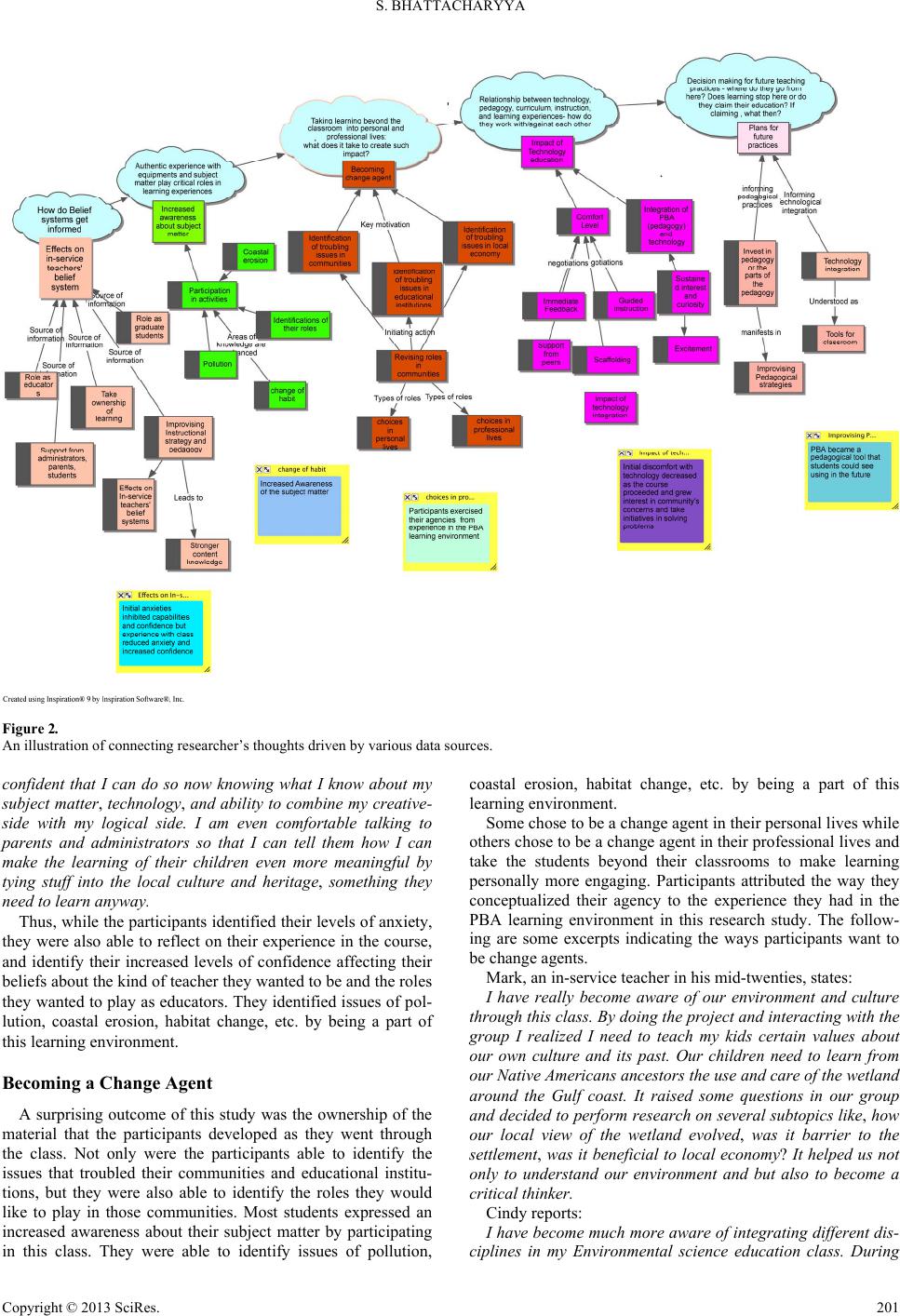 S. BHATTACHARYYA Copyright © 2013 SciRe s . 201 Figure 2. An illustration of connecting researcher’s thoughts driven by various data sources. confident that I can do so now knowing what I know about my subject matter, technology, and ability to combine my creative- side with my logical side. I am even comfortable talking to parents and administrators so that I can tell them how I can make the learning of their children even more meaningful by tying stuff into the local culture and heritage, something they need to learn anyway. Thus, while the participants identified their levels of anxiety, they were also able to reflect on their experience in the course, and identify their increased levels of confidence affecting their beliefs about the kind of teacher they wanted to be and the roles they wanted to play as educators. They identified issues of pol- lution, coastal erosion, habitat change, etc. by being a part of this learning environment. Becoming a Change Agent A surprising outcome of this study was the ownership of the material that the participants developed as they went through the class. Not only were the participants able to identify the issues that troubled their communities and educational institu- tions, but they were also able to identify the roles they would like to play in those communities. Most students expressed an increased awareness about their subject matter by participating in this class. They were able to identify issues of pollution, coastal erosion, habitat change, etc. by being a part of this learning environment. Some chose to be a change agent in their personal lives while others chose to be a change agent in their professional lives and take the students beyond their classrooms to make learning personally more engaging. Participants attributed the way they conceptualized their agency to the experience they had in the PBA learning environment in this research study. The follow- ing are some excerpts indicating the ways participants want to be change agents. Mark, an in-service teacher in his mid-twenties, states: I have really become aware of our environment and culture through this class. By doing the project and interacting with the group I realized I need to teach my kids certain values about our own culture and its past. Our children need to learn from our Native Americans ancestors the use and care of the wetland around the Gulf coast. It raised some questions in our group and decided to perform research on several subtopics like, how our local view of the wetland evolved, was it barrier to the settlement, was it beneficial to local economy? It helped us not only to understand our environment and but also to become a critical th i nker. Cindy reports: I have become much more aware of integrating different dis- ciplines in my Environmental science education class. During 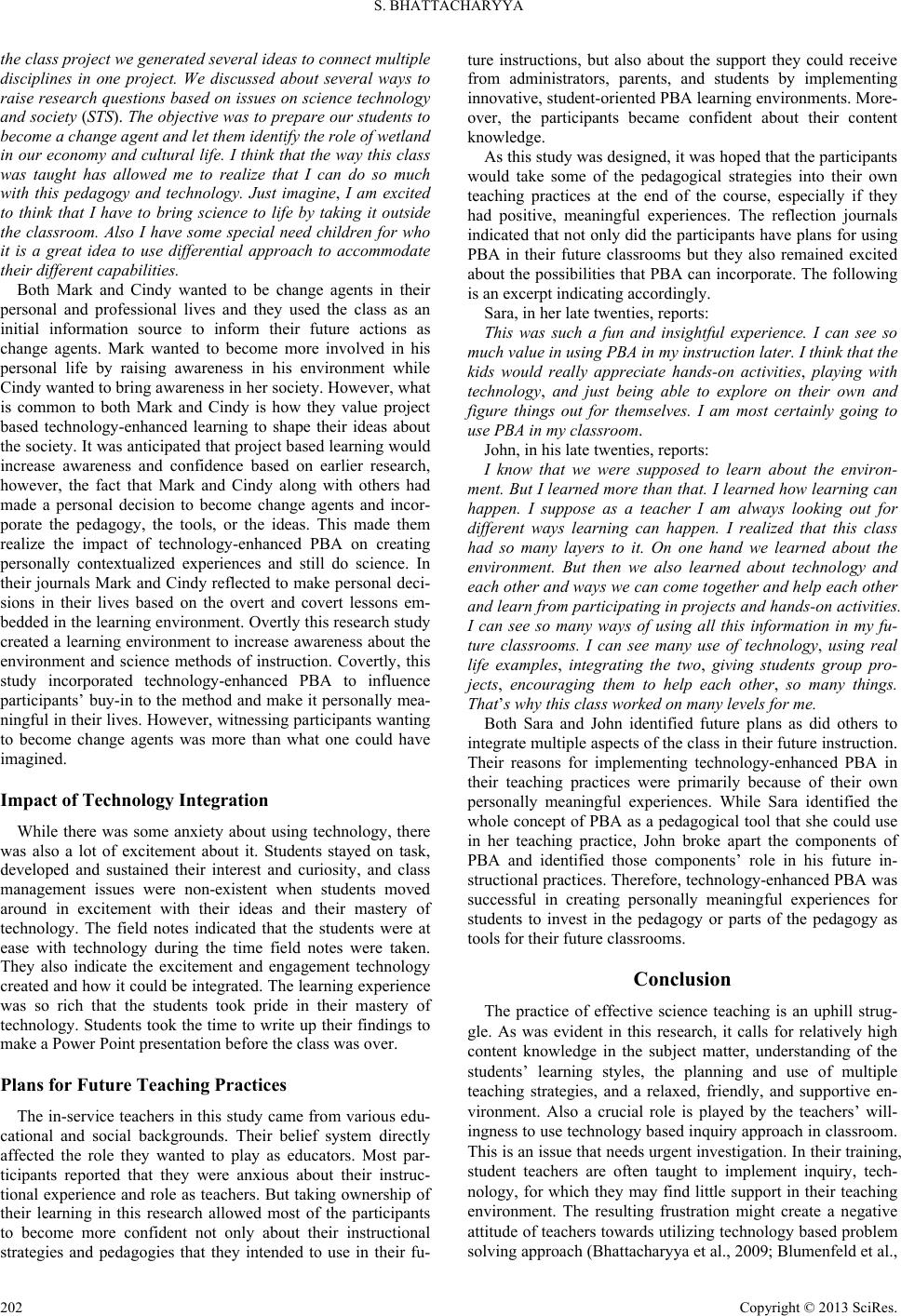 S. BHATTACHARYYA the class project we generated several ideas to connect multiple disciplines in one project. We discussed about several ways to raise research questions based on issues on science technology and society (STS). The objective was to prepare our students to become a change agent and let them identify the role of wetland in our economy and cultural life. I think that the way this class was taught has allowed me to realize that I can do so much with this pedagogy and technology. Just imagine, I am excited to think that I have to bring science to life by taking it outside the classroom. Also I have some special need children for who it is a great idea to use differential approach to accommodate their different capabilities. Both Mark and Cindy wanted to be change agents in their personal and professional lives and they used the class as an initial information source to inform their future actions as change agents. Mark wanted to become more involved in his personal life by raising awareness in his environment while Cindy wanted to bring awareness in her society. However, what is common to both Mark and Cindy is how they value project based technology-enhanced learning to shape their ideas about the society. It was anticipated that project based learning would increase awareness and confidence based on earlier research, however, the fact that Mark and Cindy along with others had made a personal decision to become change agents and incor- porate the pedagogy, the tools, or the ideas. This made them realize the impact of technology-enhanced PBA on creating personally contextualized experiences and still do science. In their journals Mark and Cindy reflected to make personal deci- sions in their lives based on the overt and covert lessons em- bedded in the learning environment. Overtly this research study created a learning environment to increase awareness about the environment and science methods of instruction. Covertly, this study incorporated technology-enhanced PBA to influence participants’ buy-in to the method and make it personally mea- ningful in their lives. However, witnessing participants wanting to become change agents was more than what one could have imagined. Impact of Technology Integration While there was some anxiety about using technology, there was also a lot of excitement about it. Students stayed on task, developed and sustained their interest and curiosity, and class management issues were non-existent when students moved around in excitement with their ideas and their mastery of technology. The field notes indicated that the students were at ease with technology during the time field notes were taken. They also indicate the excitement and engagement technology created and how it could be integrated. The learning experience was so rich that the students took pride in their mastery of technology. Students took the time to write up their findings to make a Power Point presentation before the class was over. Plans for Future Teaching Practices The in-service teachers in this study came from various edu- cational and social backgrounds. Their belief system directly affected the role they wanted to play as educators. Most par- ticipants reported that they were anxious about their instruc- tional experience and role as teachers. But taking ownership of their learning in this research allowed most of the participants to become more confident not only about their instructional strategies and pedagogies that they intended to use in their fu- ture instructions, but also about the support they could receive from administrators, parents, and students by implementing innovative, student-oriented PBA learning environments. More- over, the participants became confident about their content knowledge. As this study was designed, it was hoped that the participants would take some of the pedagogical strategies into their own teaching practices at the end of the course, especially if they had positive, meaningful experiences. The reflection journals indicated that not only did the participants have plans for using PBA in their future classrooms but they also remained excited about the possibilities that PBA can incorporate. The following is an excerpt indicating accordingly. Sara, in her late twenties, reports: This was such a fun and insightful experience. I can see so much value in using PBA in my instruction later. I think that the kids would really appreciate hands-on activities, playing with technology, and just being able to explore on their own and figure things out for themselves. I am most certainly going to use PBA in my classroom. John, in his late twenties, reports: I know that we were supposed to learn about the environ- ment. But I learned more than that. I learned how learning can happen. I suppose as a teacher I am always looking out for different ways learning can happen. I realized that this class had so many layers to it. On one hand we learned about the environment. But then we also learned about technology and each other and ways we can come together and help each other and learn from participating in projects and hands-on activities. I can see so many ways of using all this information in my fu- ture classrooms. I can see many use of technology, using real life examples, integrating the two, giving students group pro- jects, encouraging them to help each other, so many things. That’s why this class worked on many levels for me. Both Sara and John identified future plans as did others to integrate multiple aspects of the class in their future instruction. Their reasons for implementing technology-enhanced PBA in their teaching practices were primarily because of their own personally meaningful experiences. While Sara identified the whole concept of PBA as a pedagogical tool that she could use in her teaching practice, John broke apart the components of PBA and identified those components’ role in his future in- structional practices. Therefore, technology-enhanced PBA was successful in creating personally meaningful experiences for students to invest in the pedagogy or parts of the pedagogy as tools for their future classrooms. Conclusion The practice of effective science teaching is an uphill strug- gle. As was evident in this research, it calls for relatively high content knowledge in the subject matter, understanding of the students’ learning styles, the planning and use of multiple teaching strategies, and a relaxed, friendly, and supportive en- vironment. Also a crucial role is played by the teachers’ will- ingness to use technology based inquiry approach in classroom. This is an issue that needs urgent investigation. In their training, student teachers are often taught to implement inquiry, tech- nology, for which they may find little support in their teaching environment. The resulting frustration might create a negative attitude of teachers towards utilizing technology based problem solving approach (Bhattacharyya et al., 2009; Blumenfeld et al., Copyright © 2013 SciRe s . 202 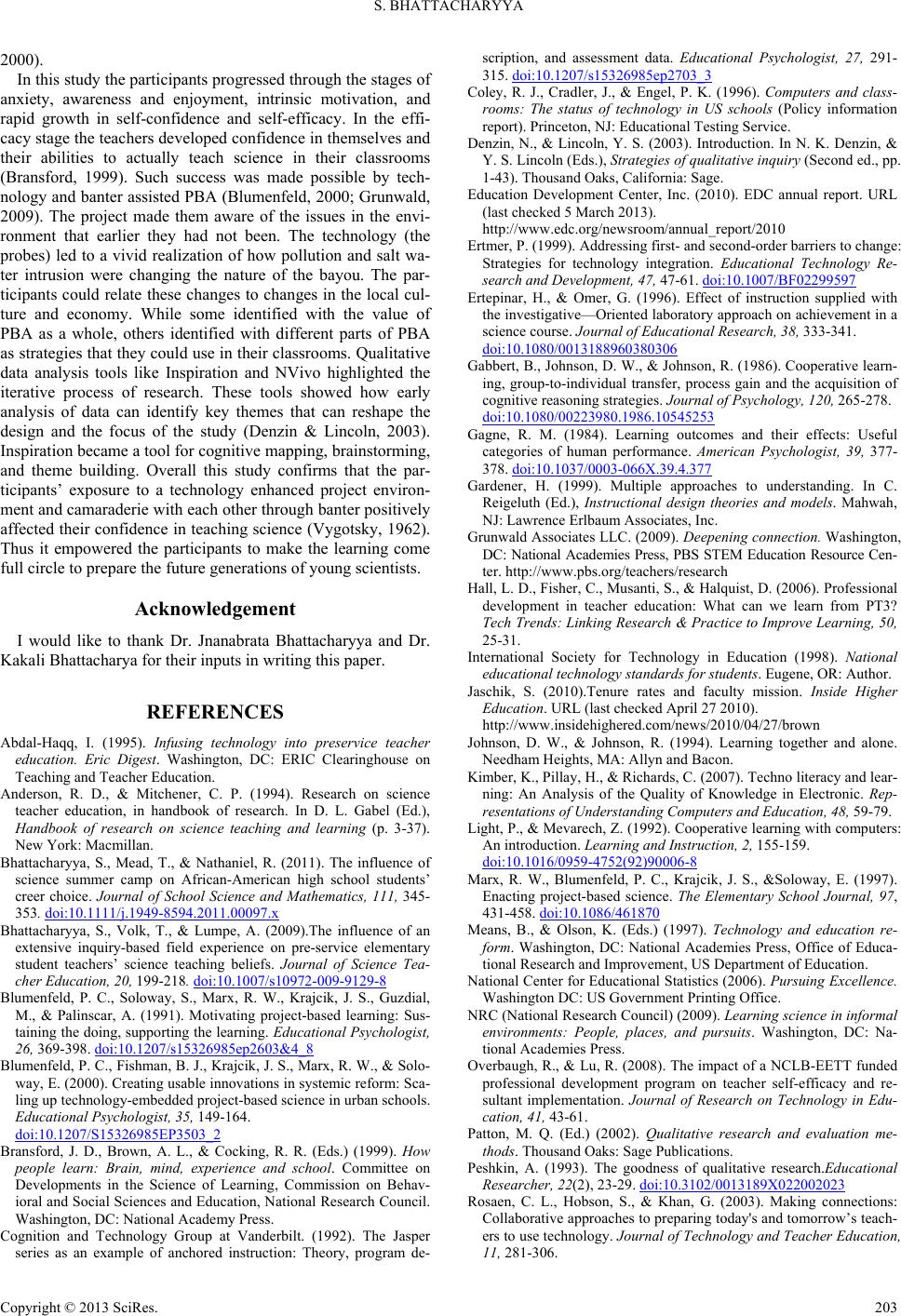 S. BHATTACHARYYA 2000). In this study the participants progressed through the stages of anxiety, awareness and enjoyment, intrinsic motivation, and rapid growth in self-confidence and self-efficacy. In the effi- cacy stage the teachers developed confidence in themselves and their abilities to actually teach science in their classrooms (Bransford, 1999). Such success was made possible by tech- nology and banter assisted PBA (Blumenfeld, 2000; Grunwald, 2009). The project made them aware of the issues in the envi- ronment that earlier they had not been. The technology (the probes) led to a vivid realization of how pollution and salt wa- ter intrusion were changing the nature of the bayou. The par- ticipants could relate these changes to changes in the local cul- ture and economy. While some identified with the value of PBA as a whole, others identified with different parts of PBA as strategies that they could use in their classrooms. Qualitative data analysis tools like Inspiration and NVivo highlighted the iterative process of research. These tools showed how early analysis of data can identify key themes that can reshape the design and the focus of the study (Denzin & Lincoln, 2003). Inspiration became a tool for cognitive mapping, brainstorming, and theme building. Overall this study confirms that the par- ticipants’ exposure to a technology enhanced project environ- ment and camaraderie with each other through banter positively affected their confidence in teaching science (Vygotsky, 1962). Thus it empowered the participants to make the learning come full circle to prepare the future generations of young scientists. Acknowledgement I would like to thank Dr. Jnanabrata Bhattacharyya and Dr. Kakali Bhattacharya for their inputs in writing this paper. REFERENCES Abdal-Haqq, I. (1995). Infusing technology into preservice teacher education. Eric Digest. Washington, DC: ERIC Clearinghouse on Teaching and Teacher Education. Anderson, R. D., & Mitchener, C. P. (1994). Research on science teacher education, in handbook of research. In D. L. Gabel (Ed.), Handbook of research on science teaching and learning (p. 3-37). New York: Macmillan. Bhattacharyya, S., Mead, T., & Nathaniel, R. (2011). The influence of science summer camp on African-American high school students’ creer choice. Journal of School Science and Mathematics, 111, 345- 353. doi:10.1111/j.1949-8594.2011.00097.x Bhattacharyya, S., Volk, T., & Lumpe, A. (2009).The influence of an extensive inquiry-based field experience on pre-service elementary student teachers’ science teaching beliefs. Journal of Science Tea- cher Education, 20, 199-218. doi:10.1007/s10972-009-9129-8 Blumenfeld, P. C., Soloway, S., Marx, R. W., Krajcik, J. S., Guzdial, M., & Palinscar, A. (1991). Motivating project-based learning: Sus- taining the doing, supporting the learning. Educational Psychologist, 26, 369-398. doi:10.1207/s15326985ep2603&4_8 Blumenfeld, P. C., Fish man, B. J., Krajcik, J . S., Marx, R. W., & Solo- way, E. (2000). Creating usable innovations in systemic reform: Sca- ling up technology-embedded project-based science in urban schools. Educational Psychologist, 35, 149-164. doi:10.1207/S15326985EP3503_2 Bransford, J. D., Brown, A. L., & Cocking, R. R. (Eds.) (1999). How people learn: Brain, mind, experience and school. Committee on Developments in the Science of Learning, Commission on Behav- ioral and Social Sciences and Education, National Research Council. Washington, DC : National Academy Press. Cognition and Technology Group at Vanderbilt. (1992). The Jasper series as an example of anchored instruction: Theory, program de- scription, and assessment data. Educational Psychologist, 27, 291- 315. doi:10.1207/s15326985ep2703_3 Coley, R. J., Cradler, J., & Engel, P. K. (1996). Computers and class- rooms: The status of technology in US schools (Policy information report). Pr inceton, NJ: Educational T esting Service. Denzin, N., & Lincoln, Y. S. (2003). Introduction. In N. K. Denzin, & Y. S. Lincoln (Eds.), Strategies of qualitative inquiry (Second ed., pp. 1-43). Thousand Oaks, California: Sage. Education Development Center, Inc. (2010). EDC annual report. URL (last checked 5 March 2013). http://www.edc.org/newsroom/annual_report/2010 Ertmer, P. (1999). Addressing first- and second-order barriers to change: Strategies for technology integration. Educational Technology Re- search and Development, 47, 47-61. doi:10.1007/BF02299597 Ertepinar, H., & Omer, G. (1996). Effect of instruction supplied with the investigative—Oriented laboratory approach on achievement in a science course. Journal of Educational Research, 38, 333-341. doi:10.1080/0013188960380306 Gabbert, B., Johnson, D. W., & Johnson, R. (1986). Cooperative learn- ing, group-to-individual transfer, process gain and the acquisition of cognitive reasoning strategies. Journal of Psychology, 120, 265-278. doi:10.1080/00223980.1986.10545253 Gagne, R. M. (1984). Learning outcomes and their effects: Useful categories of human performance. American Psychologist, 39, 377- 378. doi:10.1037/0003-066X.39.4.377 Gardener, H. (1999). Multiple approaches to understanding. In C. Reigeluth (Ed.), Instructional design theories and models. Mahwah, NJ: Lawrence Erlbaum Associates, Inc. Grunwald Associates LLC. (2009). Deepening connection. Washington, DC: National Acad emies Press, PBS STEM Education Resource Cen- ter. http://www.pbs.org/teachers/research Hall, L. D., Fisher, C., Musanti, S., & Halquist, D. (2006). Professional development in teacher education: What can we learn from PT3? Tech Trends: Linking Research & Practice to Improve Learning, 50, 25-31. International Society for Technology in Education (1998). National educational technology standards for stud e nt s. Eugene, OR: Author. Jaschik, S. (2010).Tenure rates and faculty mission. Inside Higher Education. URL (last checked April 27 2010). http://www.insidehighered.com/news/2010/04/27/brown Johnson, D. W., & Johnson, R. (1994). Learning together and alone. Needham Heights, MA: Allyn and Bacon. Kimber, K., Pillay, H., & Richards, C. (2007). Techno literacy and lear- ning: An Analysis of the Quality of Knowledge in Electronic. Rep- resentations of Understanding Computers and E d uc a ti on, 48, 59-79. Light, P., & Mevarech, Z. (1992). Cooperative learning with computers: An introduction. Learning and Instruction, 2, 155-159. doi:10.1016/0959-4752(92)90006-8 Marx, R. W., Blumenfeld, P. C., Krajcik, J. S., &Soloway, E. (1997). Enacting project-based science. The Elementary School Journal, 97, 431-458. doi:10.1086/461870 Means, B., & Olson, K. (Eds.) (1997). Technology and education re- form. Washington, DC: National Academies Press, Office of Educa- tional Research and Impro ve ment, US Departme n t of E d uc at i on . National Center for Educational Statistics (2006). Pursuing Excellence. Washington DC: US Government Printing Office. NRC (National Research Council) (2009). Learning science in informal environments: People, places, and pursuits. Washington, DC: Na- tional Academies Press. Overbaugh, R., & Lu, R. (2008). The impact of a NCLB-EETT funded professional development program on teacher self-efficacy and re- sultant implementation. Journal of Research on Technology in Edu- cation, 41, 43-61. Patton, M. Q. (Ed.) (2002). Qualitative research and evaluation me- thods. Thousand Oaks: Sage Publications. Peshkin, A. (1993). The goodness of qualitative research.Educational Researcher, 22( 2), 23-29. doi:10.3102/0013189X022002023 Rosaen, C. L., Hobson, S., & Khan, G. (2003). Making connections: Collaborative approaches to preparing today's and tomorrow’s teach- ers to use technology. Journal of Technology and Teacher Education, 11, 281-306. Copyright © 2013 SciRe s . 203 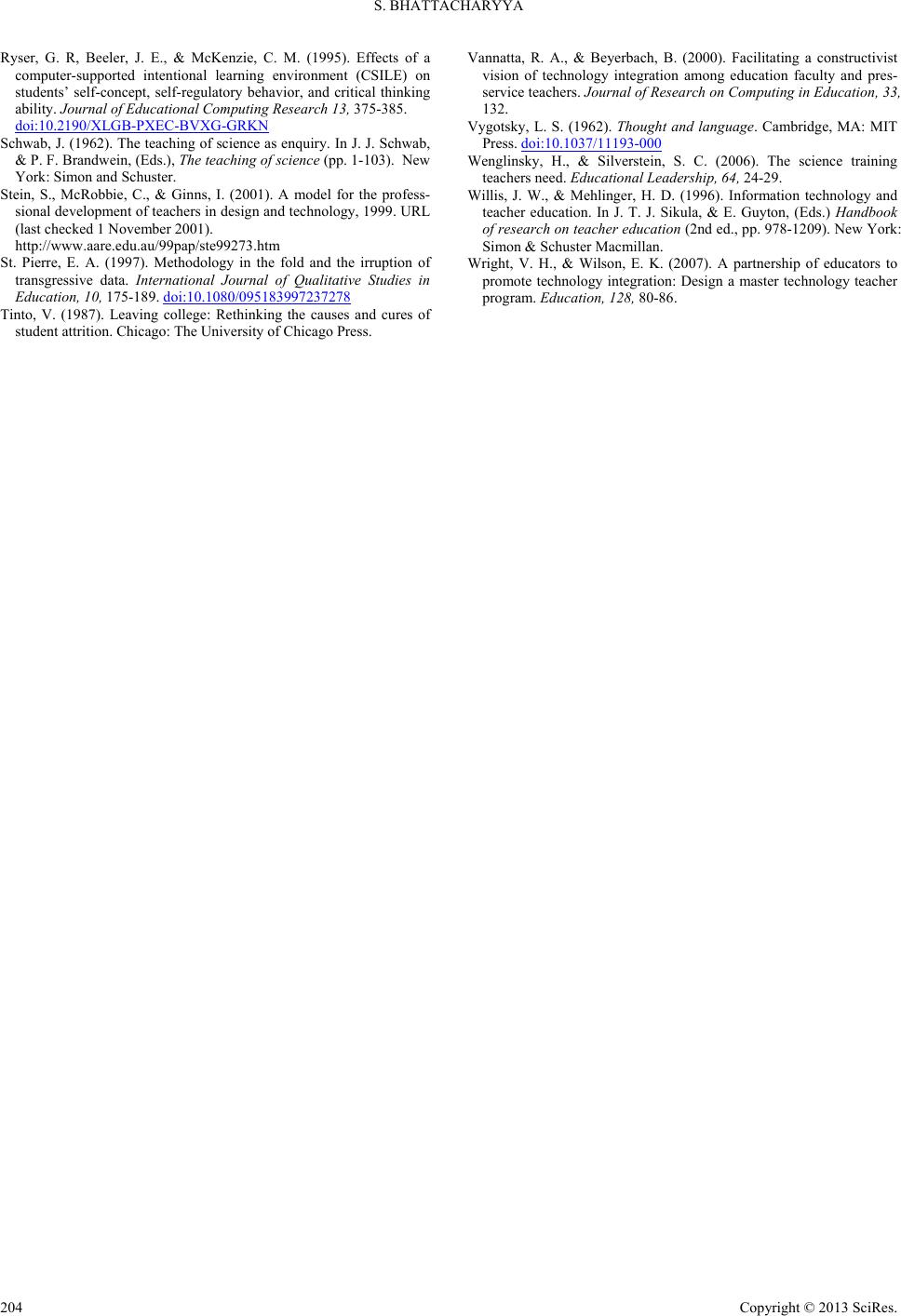 S. BHATTACHARYYA Copyright © 2013 SciRe s . 204 Ryser, G. R, Beeler, J. E., & McKenzie, C. M. (1995). Effects of a computer-supported intentional learning environment (CSILE) on students’ self-concept, self-regulatory behavior, and critical thinking ability. Journal of Educational Co mputing Research 13, 375-385. doi:10.2190/XLGB-PXEC-BVXG-GRKN Schwab, J. (1962). The teaching of science as enquiry. In J. J. Schwab, & P. F. Brandwein, (Eds.), The teaching of science (pp. 1-103). New York: Simon and Schuster. Stein, S., McRobbie, C., & Ginns, I. (2001). A model for the profess- sional development of teachers in design and technology, 1999. URL (last checked 1 November 2001 ). http://www.aare.edu.au/99pap/ste99273.htm St. Pierre, E. A. (1997). Methodology in the fold and the irruption of transgressive data. International Journal of Qualitative Studies in Education, 10, 175-189. doi:10.1080/095183997237278 Tinto, V. (1987). Leaving college: Rethinking the causes and cures of student attrition. Chicago: The Universi ty of Chicago Press. Vannatta, R. A., & Beyerbach, B. (2000). Facilitating a constructivist vision of technology integration among education faculty and pres- service teachers. Journal of Research on Computing in Education, 33, 132. Vygotsky, L. S. (1962). Thought and language. Cambridge, MA: MIT Press. doi:10.1037/11193-000 Wenglinsky, H., & Silverstein, S. C. (2006). The science training teachers need. Educational Leadership, 64 , 24-29. Willis, J. W., & Mehlinger, H. D. (1996). Information technology and teacher education. In J. T. J. Sikula, & E. Guyton, (Eds.) Handbook of research on teacher education (2nd ed., pp. 978-1209). New York: Simon & Schuster Macmillan. Wright, V. H., & Wilson, E. K. (2007). A partnership of educators to promote technology integration: Design a master technology teacher program. Education, 128, 80- 86.
|